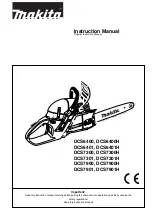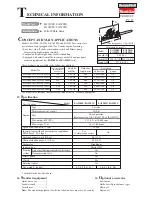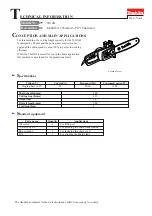
•
FUEL MIXING TABLE
•
RECOMMENDED FUELS
Some conventional gasolines are being blended with oxy-
genates such as alcohol or an ether compound to meet
clean air standards. Your Talon engine is designed to
operate satisfactorily on any gasoline intended for auto-
motive use including oxygenated gasolines.
•
CHAIN AND BAR LUBRICATION
Always refill the chain oil tank each time the fuel tank is
refilled.
• ENGINE PRE-START CHECKS
1. Fill the fuel tank (A) with correct fuel mixture (Fig. 6).
2. Fill the oil tank (B) with correct chain and bar oil (Fig.
6).
3. Be certain the chain brake is disengaged (C) before
starting unit (Fig. 6).
• TO START ENGINE
1. Slide STOP switch (D) down for starting (Fig. 7A).
The choke has 3 positions: RUN (A), HALF (B) and
CHOKE (C) (Fig. 7B).
2. Move the choke lever (E) to
(CHOKE) (Fig. 7C).
3. Push the primer bulb (F) 10 times (Fig. 7D).
4.
Activate throttle latch: depress throttle latch (A), then
squeeze throttle trigger (B), release trigger and then
the latch (Fig. 7E).
5.
Grip the front handle firmly with left hand, place your
right foot through the rear handle, and pull the starter
rope quickly with your right hand until the engine
sounds as if it is trying to start. (Fig.7F)
IMPORTANT: Do not pull the starter rope more than 2-3
times as this may flood the engine.
6.
Move choke lever (D) to
(HALF) (Fig.7G).
7.
Hold saw firmly and pull starter rapidly 4 times.
Engine should start (Fig. 7H).
8.
Warm up for 10 seconds. Depress and release trig-
ger (E) for IDLE, then go to step 9 (Fig. 7J).
9.
Move choke lever (F) to
(RUN) (Fig. 7K). If engine
failed to start, repeat these instructions.
• RE-STARTING A WARM ENGINE
1. Make sure the STOP switch is in the ON position.
2. Move the choke lever to
(HALF).
3. Depress the primer bulb 10 times.
4. Set the throttle latch.
5. Pull the starter rope rapidly 4 times. The engine
should start.
6. Move the choke lever to
(RUN).
7. Release the throttle latch.
•
TO STOP ENGINE
1. Release trigger and allow engine to return to idle
speed.
2. Move STOP switch up to stop engine.
NOTE:
For emergency stopping, simply activate chain
brake and move STOP switch up.
•
CHAIN BRAKE OPERATIONAL TEST
Test the chain brake periodically to ensure proper function.
Perform a chain brake test prior to initial cutting, following
extensive cutting, and definitely following any Chain brake
service.
AU
9
8
AU
OPERATING INSTRUCTIONS
Fig. 6
C
B
A
Fig. 7A
Fig. 7B
A
Fig. 7E
Fig. 7F
A
Fig. 7G
Fig. 7H
D
F
Fig. 7J
Fig. 7K
F
B
GASOLINE
25:1 Ratio Lubricant
5 Liters
6.7 oz.
200ml (cc)
1 lmp. Gal.
6.1 oz.
180ml (cc)
Mixing
25 Parts Gasoline
Procedure
to 1 part Lubricant
1ml = 1cc
Fig. 7C
Fig. 7D
E
F
TEST
CHAIN BRAKE
AS FOLLOWS:
1. Place saw on a clear, firm, flat surface.
2. Start
engine.
3. Grasp the rear handle (A) with your right hand.
(Fig. 8)
4. With your left hand, hold the front handle (B) [not
chain brake lever (C)] firmly.
5. Squeeze the throttle trigger to 1/3 throttle, then
immediately activate the chain brake lever (C).
6. Chain should stop abruptly. When it does,
immediately release the throttle trigger.
7. If chain brake functions properly, turn the engine off
and return the chain brake to the DISENGAGED
position.
• SAW CHAIN / BAR LUBRICATION
Adequate lubrication of the saw chain is essential at all
times to minimize friction with the guide bar.
Never starve the bar and chain of oil. Running the saw
with too little oil will decrease cutting efficiency, shorten
saw chain life, cause rapid dulling of chain, and cause
excessive wear of bar from overheating. Too little oil is
evidenced by smoke, bar discoloration or pitch build-up.
NOTE:
Saw chain stretches during use, particularly when
it is new, and it will occasionally be necessary to adjust
and tighten it. New chain will require adjustment after
about 5 minutes of operation.
• AUTOMATIC OILER
Your chain saw is equipped with an automatic gear driven
oiler system. The oiler automatically delivers the proper
amount of oil to the bar and chain. As the engine speed
increases, so does the oil flow to the bar pad. The amount
of oil flowing to the bar and chain may be changed by
turning the adjustment screw (A) as shown in Fig. 9. Turn
the screw clockwise to DECREASE oil flow and counter-
clockwise to INCREASE the flow.
•
FELLING
Felling is the term for cutting down a tree. Small trees up
to 6-7 inches (15-18cm) in diameter are usually cut in a
single cut. Larger trees require notch cuts. Notch cuts
determine the direction the tree will fall.
FELLING A TREE:
NOTE:
Direction of fall (B) is controlled by the notching
cut. Before any cuts are made, consider the location of
larger branches and natural lean of the tree to determine
the way the tree will fall.
GENERAL GUIDELINES FOR FELLING TREES:
Normally felling consists of 2 main cutting operations,
notching (C) and making the felling cut (D).
Start making the upper notch cut (C) on the side of the
tree facing the felling direction (E). Be sure you don t
make the lower cut too deep into the trunk.
The notch (C) should be deep enough to create a hinge
(F) of sufficient width and strength. The notch should be
wide enough to direct the fall of the tree for as long as
possible.
Fig. 8
A
B
C
WARNING
: Activate the chain brake slowly and
deliberately. Keep the chain from touching any-
thing; don t let the saw tip forward.
WARNING
: If chain does not stop, turn
engine off and take your unit to the nearest
Talon Authorized Service Center for service.
Fig. 9
A
GENERAL CUTTING INSTRUCTIONS
WARNING
: A retreat path (A) should be planned
and cleared as necessary before cuts are
started. The retreat path should extend back and
diagonally to the rear of the expected line of fall,
as illustrated in Fig. 10A.
CAUTION
: If felling a tree on sloping ground, the
chain saw operator should keep on the uphill
side of the terrain, as the tree is likely to roll or
slide downhill after it is felled.
Fig. 10A
B
A
WARNING
: Do not cut down a tree during high or
changing winds or if there is a danger to property.
Consult a tree professional. Do not cut down a
tree if there is a danger of striking utility wires;
notify the utility company before making any cuts.

























